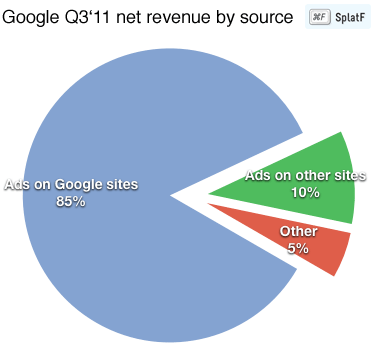How does Google make money?
 In a word: Ads.
In a word: Ads.
This past quarter, Google generated $9.7 billion of total gross revenue. Of that, almost all of it was from advertising, both on Google’s sites and on its network “partner” sites, which run Google’s AdSense ads.
But Google doesn’t get to keep all of that money — it pays out a bunch each quarter to publishers that run Google’s AdSense ads on their sites or in their mobile apps. That’s called “traffic acquisition costs,” or TAC. Last quarter, TAC was about $2.2 billion, or 24% of total gross ad sales.
Specifically, Google says it paid out $1.8 billion last quarter to AdSense partners, and another $400 million to “certain distribution partners and others who direct traffic to our website.” (This second part, I subtracted from the “Google Sites” revenue. Ping me if that’s incorrect.)
The revenue Google actually gets to keep after paying out TAC is “net revenue.” That’s what you see in this chart — gross revenue minus TAC. I didn’t take into account Google’s other costs, including datacenter operations, content acquisition costs, and credit card fees, which totaled $1.17 billion, or 12% of gross revenue.
About 85% of Google’s net revenue comes from ads running on Google sites. About 10% comes from ads running on other sites. And about 5% comes from “other,” which includes Google Apps subscriptions, search appliance sales, etc. Google noted today on its earnings call that its ITA Software acquisition, which powers airfare search, helped contribute to a bump in “other” revenue this past quarter.

Check out my new site: The New Consumer, a publication about how and why people spend their time and money.

